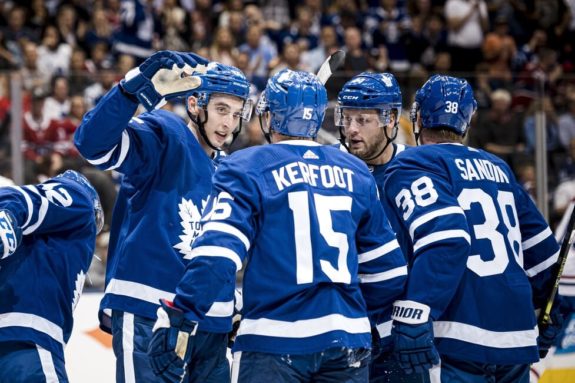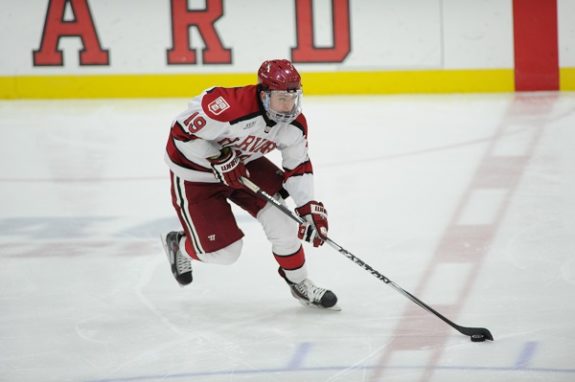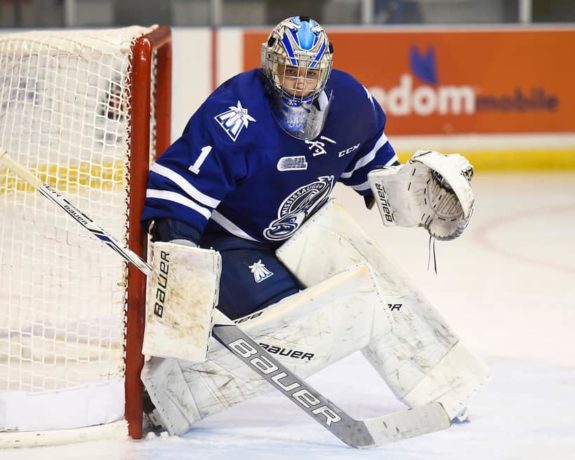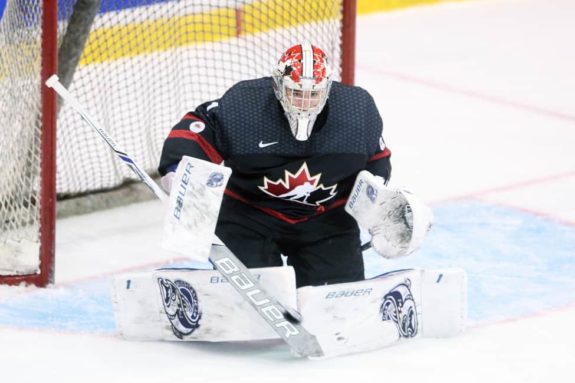Not every player is in a rush to play professional hockey. Some elite-level talents are able to prioritize other endeavors ahead of getting an NHL career started. Patience can be rewarded.
Such was the case for Alexander Kerfoot. He was born into a privileged household (His father bought the Vancouver Whitecaps FC of Major League Soccer (MLS) in 2002.), allowing him to take his time before earning a paycheck doing what he does best, play hockey.
Kerfoot played his junior years in the British Colombia Hockey League (BCHL) where he was decorated with awards. Along with earning a spot on the All-Rookie and First All-Star teams, Kerfoot was awarded the Bruce Allison Memorial Trophy for his Rookie of the Year campaign. He also won the Bob Fenton Trophy as the league’s most sportsmanlike player.
The New Jersey Devils took notice of Kerfoot and selected his rights in the fifth round of the 2012 NHL Entry Draft. He went 150th overall, one slot ahead of Sault Ste. Marie Greyhounds defenseman, Colin Miller.
Two Distinct Paths to the NHL
Kerfoot and Miller took different paths to the NHL. While both players returned to their junior club for another season, Miller signed with the team that drafted him, the Los Angeles Kings. Kerfoot and the Devils didn’t come to terms. Instead, he committed to play for Harvard University in the NCAA.
Miller went on to compete in the American Hockey League for the Kings affiliate, the Manchester Monarchs. He was then included as a part of the return to the Boston Bruins when they traded away Milan Lucic. Miller now patrols the blue line for the Buffalo Sabres after a two-year stop with the Vegas Golden Knights.
Meanwhile, Kerfoot put four years into Harvard, playing with the Crimson men’s ice hockey team and earning his degree in economics. It was a move that established a contingency plan should his hockey career not work out as intended.

Luckily, Kerfoot excelled with Crimson. In his senior year, he was named co-captain of the team. On the ice, his performance earned him a place on the ECAC Hockey and Ivy League first-team, CCM/AHCA East All-American second team, and a top 10 finalist position for the Hobey Baker Award. Kerfoot even won the John Tudor Memorial Cup as his team’s most valuable player.
Thanks to Kerfoot’s patience and success in the NCAA, he had the rare opportunity to choose the NHL experience that best suited him. He had that luxury thanks to his free-agent status and agreed to a deal with the Colorado Avalanche.
He explained his decision to a team reporter:
“I was primarily looking for a place that I thought I could come in and play right away. I thought there was an opportunity to come in and compete for a spot here with the Avalanche. Denver is a great city and on top of that I just felt like my conversations with Joe Sakic and Jared Bednar went really well. I am excited where they are taking this organization.”
Alex Kerfoot
Kerfoot was a free agent because over four years had passed since he was drafted. Based on Article 8.6, Reserve List-Exclusive Rights, in the NHL players’ collective bargaining agreement, a team loses their draft rights after that elapsed timeframe.
Jimmy Vesey Did It Too
Taking advantage of this clause in the CBA was not unique to Kerfoot. He saw his Harvard teammate, Jimmy Vesey, who was drafted by the Nashville Predators in the third round, let those rights expire as well. Doing so allowed Vesey to select playing on his desired team, the New York Rangers.

Neither Kerfoot or Vesey were locks to become NHL players when their names were called in the 2012 Draft. They could have attempted taking the same route as Miller, but doing so would have left them vulnerable to their respective NHL franchise’s decision making. They would have had them compete against the established depth chart of their organization. Instead, they were each able to survey the NHL landscape to find their ideal fit.
There Is an OHL Goalie Who May Be in the Same Situation
Currently, there is a player in the Ontario Hockey League (OHL) who is turning heads and will soon be faced with focusing on his playing future. He’s the 66-foot-4 goaltender for the Kitchener Rangers, Jacob Ingham.
Ingham was selected by the Kings in the sixth round of the 2018 NHL Entry Draft after demonstrating his potential as a member of the Mississauga Steelheads.
He was traded to Kitchener this past offseason when their primary goalie, Luke Richardson, departed to play USports. Ingham was the desired replacement, which is why the Rangers gave up the package of four future draft picks to get him.
Now in his fourth season, Ingham should help the Rangers remain a contender in the OHL. He is not only an imposing figure between the pipes, but also puts his athleticism on display nightly. That helps him post very respectable numbers.

Last season Ingham played 57 of Mississauga’s 68 games. He helped the team make it to the playoffs, posting a .890 save percentage and a 3.41 goals-against average. Those figures may improve as Ingham has gotten off to an impressive start in 2019-20. He recently had a 43-save performance at home.
Ingham’s Options Were Laid out by the Players Who Came Before Him
When planning what to do when he’s no longer eligible for junior hockey, Ingham can use others’ examples to help him create a roadmap for his future. Richardson’s decision was to join the Queen’s University Golden Gaels and take advantage of the Canadian Hockey League (CHL) Scholarship.
Players earn a package for every season they play in one of the CHL’s leagues. It covers the costs of tuition, books and other mandatory fees to attend a Canadian institution.
Playing USports would also allow Igham to also pursue a degree. Unfortunately, very few players have made the jump from a Canadian University team to the NHL though it has been done. Notably, Joel Ward, Darryl Boyce, Jody Shelley, Mathieu Darche, P.J. Stock, and Stu Grimson have all made the leap.
Like Kerfoot demonstrated, Ingham would need to play two more seasons beyond this current one to ensure that his NHL rights no longer belong to the Kings. When Ingham is through with the OHL. he will have no shortage of suitors. He’ll just need to decide which league is best for the next chapter of his life.
Assuming Ingham and the Kings don’t come to terms, he will likely be looking at joining a university program or going overseas to play pro hockey.

One option that no longer exists for Ingham is participating in NCAA. Their regulations say that anyone who signed a contract in the CHL forfeits their eligibility.
Should Ingham attempt to follow Kerfoot’s lead and if he is able to dominate in his post OHL career, his agent should be in a position to start making demands of NHL clubs.
Time will tell how Ingham’s hockey future plays out, but his talents should allow him to keep playing for years.